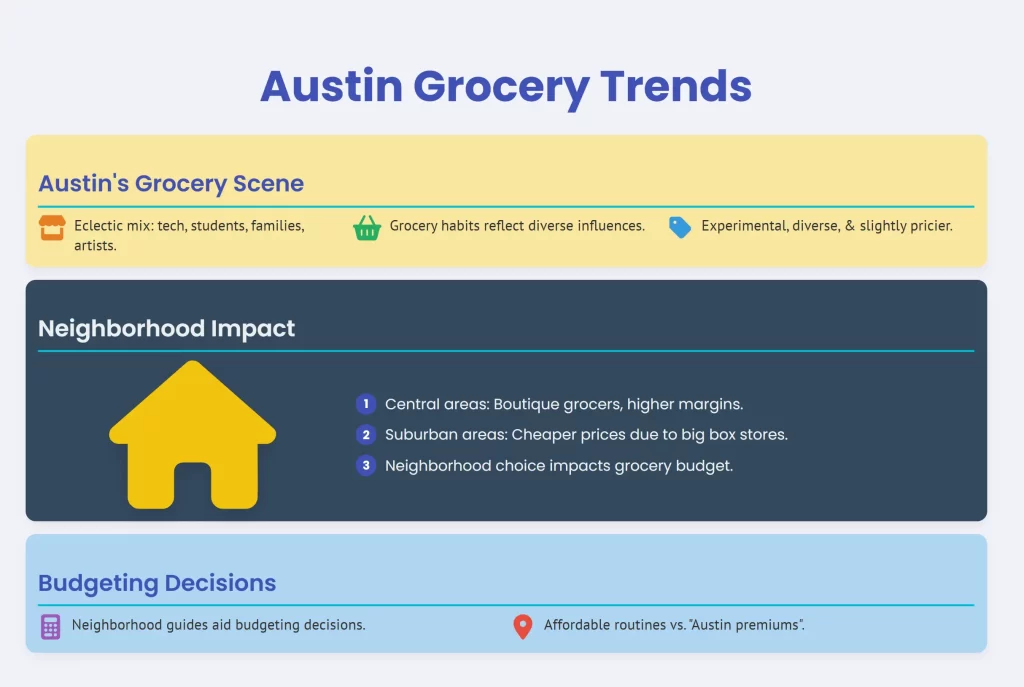Moving into a new city is more than arranging furniture and finding a lease. Each trip to the store rewrites your budget and subtly shifts your lifestyle. Few line items reveal the rhythm of local life like groceries. In Texas, a state famed for its barbecue pits and backyard cookouts, every dollar spent at H‑E‑B, Kroger, or Fiesta adds up to shape how comfortable you’ll feel week after week.
So here we are in September 2025, watching food inflation cool nationwide but still leaving its imprint across Texas cities. Austin, Dallas, and Houston all demonstrate how geography, lifestyle preferences, and supply chains play out every time you grab apples or stock up on tortillas.
If you’re planning your move to Austin, building clarity around this ordinary routine eases the broader transition. Plenty of locals swear by a comprehensive neighborhood guide trusted by many residents to balance lifestyle costs—and you may find it invaluable for mapping where your grocery budget stretches furthest.
Explore the Austin Neighborhoods Guide here.
The Numbers: Grocery Index in September 2025
According to USDA regional reports, BLS consumer price indexes, and local Austin grocer surveys, here’s where the data stands:
| Category | Austin Avg (Sept 2025) | Dallas Avg (Sept 2025) | Houston Avg (Sept 2025) |
|---|---|---|---|
| Milk (1 gal) | $4.35 | $4.10 | $4.05 |
| Eggs (doz) | $3.25 | $3.10 | $3.15 |
| Chicken (lb) | $2.89 | $2.78 | $2.96 |
| Bread (loaf) | $3.05 | $2.95 | $3.00 |
| Apples (per lb) | $1.95 | $1.82 | $1.88 |
| Rice (2 lb bag) | $4.50 | $4.25 | $4.40 |
| Beer (6‑pack) | $10.49 | $9.90 | $9.75 |
| Coffee (12 oz) | $6.75 | $6.55 | $6.40 |
Key takeaway: Routine grocery costs sit 3–5% higher in Austin compared to its metro peers. Consumers feel it most in perishable staples like milk and fresh fruit, while proteins remain relatively consistent.
Why Austin Costs Drift Higher
- Supply Chain Pressure
Rapid population growth keeps supply tight. Retailers struggle during peak summer migration bursts when thousands of new households arrive. - Lifestyle Demand
Austin leans artisanal. Specialty bakeries, craft breweries, and organic farms influence average spend across zip codes like Mueller and South Congress. - Distribution Costs
Dallas and Houston enjoy easier logistics as regional distribution hubs. Austin, tucked closer to Hill Country, still pays a slight premium in freight costs.
Building a Realistic Grocery Budget in Austin
Based on local averages, a single adult spends ~$325–$350 monthly on basic groceries, while a family of four averages $1,050–$1,150. That’s roughly 5–7% above Dallas families, and 3–4% above Houston.
Factor these costs into broader planning using the Austin cost of living guide. Grocery differentials may seem small, but layered with housing, utilities, and transit, they shape your broader lifestyle.
Practical Ways to Stretch Every Dollar
- Loyalty Apps: H‑E‑B’s MyHEB app offers weekly discounts—residents report ~10% net savings.
- Bulk Buys: Storing staples like rice or grains using long‑term food storage containers reduces midweek “top‑off” trips.
- Farmers Markets: Who said quality costs extra? East Austin Saturday markets deliver fresh produce at lower-than-retail rates when you buy direct.
Table: Monthly Grocery Burden by City (Sept 2025)
| Profile | Austin | Dallas | Houston |
|---|---|---|---|
| Single Adult | $340 | $322 | $327 |
| Couple | $650 | $622 | $628 |
| Family of Four | $1,110 | $1,048 | $1,072 |
This chart underscores what renters already feel: moving to Austin comes not only with rental premiums but small, steady upgrades in basic expenses.
The Human Side of Grocery Shopping

Walking through Austin H‑E‑Bs, you’ll notice checkout lines filled with brisket, kombucha, and gluten‑free loaves side‑by‑side. Austin is culturally eclectic, which means grocery habits reflect a fusion of tech professionals, students, families, and artists—all influencing what stores stock and how much you pay.
And while Dallas stores feel conventionally suburban and Houston markets lean global, Austin’s grocery aisles mirror its lifestyle: experimental, diverse, and slightly pricier.
How Grocery Budgets Shape Neighborhood Choice
Think neighborhoods don’t affect grocery costs? They do. Central neighborhoods near Barton Springs skew toward high‑margin boutique grocers. Out by Cedar Park or Pflugerville, the same apples ring cheaper, thanks to proximity to suburban Walmarts and Costco hubs.
That’s why selecting a neighborhood isn’t just housing—it’s a budgeting decision. Many movers rely on the deep neighborhood guide exactly for this context: which areas foster affordable weekly routines and which amplify “Austin premiums.”
Moving‑Day Grocery Strategy
Once you arrive in Austin, timing is everything. Local pro‑tip: stock frozen staples before your official move‑in day. That way, you aren’t spending twice—first on expensive takeout while exhausted, then on groceries later.
Equip yourself with essentials like stackable cooler bags so perishables travel safely between your truck and your first fridge. Pair this with the Moving to Austin guide to smooth first‑week chaos.
Looking Ahead Into 2026
- Inflation Cooling: USDA forecasts ~2% annual grocery inflation nationwide for 2026, meaning stability is in view.
- Eco‑Packaging Surge: Austin’s grocers already pilot reusable container programs that may trim packaging costs.
- Warehouse Growth: New distribution centers east of the city may finally narrow the Austin premium within two years.
Living Proof: How Groceries Reflect Austin’s Character
Groceries, like rent, reveal the heartbeat of a city. Austin’s cart holds kombucha next to brisket, organic kale beside breakfast tacos. In between those aisles is the story of a city always rewriting itself—less “cheap,” more “alive, abundant, and varied.”
If you want to dig deeper into how those lifestyle costs braid into housing and community, turn to a comprehensive neighborhood guide many Austinites swear by. Pair it with local insights from Best Neighborhoods in Austin and you’ll build clarity not just on groceries, but on where life feels balanced overall.